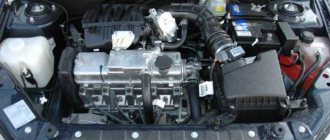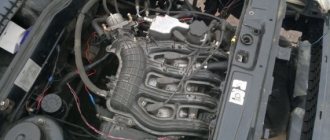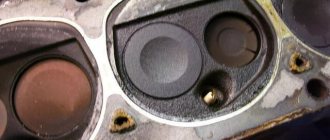Updated: 01/11/2022
Domestic cars remain the most popular in Russia. Buyers are practically forced to vote with their wallets for Ladas due to the lack of any reasonable alternatives. This is not to say that AvtoVAZ’s creations are available to buyers in the Russian Federation cheaply. Some configurations of domestic cars go far beyond a million rubles. And although it sounds paradoxical, someone still buys them. But today we will talk not so much about the marketing part, but about the technical part. If you are buying a Lada for a million, you would like to be sure that it will not break down due to some annoying error in the service.
In our article today we will look at which VAZ engines do not bend valves when the timing belt or chain breaks or jumps. And you will be surprised, but there are such engines in the line of domestic manufacturers. Unfortunately, until 2022, most engines still bent valves due to timing belt problems, but in new Lada engines this problem has actually been corrected.
So today we will look at several extremely important questions:
- VAZ engines on which the valves do not bend when the timing belt or chain breaks;
- Methods of protection against bending of valves in domestic engines;
- Specific examples of belt breaks on modern engines;
- How much does it cost to repair a VAZ engine after a broken timing belt.
Go!
Pistons of 8-valve engines
We are talking about engines 2111 and 21114. They are injection engines, and the shape of the pistons was inherited from the carburetor engine 2110.
ShPG elements (pistons) 2110-1004015
Actually, the same pistons were installed on three different 8-valve valves: 2110, 2111 (1.5 8v), 21114 (1.6 8v). Piston article number – 2110-1004015.
Two deep recesses ensure that any of the valves, intake or exhaust, cannot “meet” the piston surface even if the timing belt breaks.
The standard 8-valve valves on the VAZ-2112 do not bend the valves, no matter what some owners say. Sometimes an “improved” camshaft is installed, and if the valves fly out more than VAZ specifies, then there will be no guarantee against bending. Therefore, follow the regulations for replacing the timing belt on an 8-valve engine.
And the following is provided:
We give values taking into account the thermal gap. Whoever exceeds them will receive the result.
VAZ 2110 - “Tenth” family and new problems
“Tens” appeared in the VAZ model line quite a long time ago, but they gained popularity in 1998. Ten years later they were discontinued, giving way to new domestically developed products. Today, the “Ten” is considered a completely adequate vehicle with certain assembly problems. These models had different engines and had different characteristics:
- The 1.5-liter 8-valve simple power unit did not bend the valves, but showed only 72 horsepower;
- a modified 1.5-liter engine with 16 valves began to actively bend these same valves;
- a more modern 1.6-liter power unit in an 8-valve design should have been gentler, but it didn’t;
- You also won’t get cheap repairs after a broken timing belt on the most powerful 1.6-liter 16-valve VAZ 2110 engine.
The entire family of “Tenth” models was of quite high quality and reliable, but the further the plant tried to keep up with power, modernity and relevance, the more trouble the car got into. The most durable and high-quality engine was the 1.5 engine with 8 valves and 72 horses, but the latest models with powerful 16-valve units only encountered problems, judging by the reviews of car owners.
Do 16 valve engines bend?
Motors 21120 and 21124 are similar in design, but their displacement is different. The pistons are also installed differently - there are differences in the depth of the grooves.
ShPG elements (pistons) 2112-1004015 and 21124-100401504
In pistons 2112-1004015, the grooves are actually made. The likelihood of bending is reduced, but it is not reduced to zero. Therefore, always pay attention to the quality of the pump and rollers when replacing the timing belt on a 16-valve engine.
The VAZ-21124 engine is one of those 16-valve engines that do not bend their valves. The grooves are made so that no valve meets the piston.
Don't make the wrong choice.
Motors 21124 are in short supply!
One of the most favorite engines in the 12 is the 124. It doesn’t bend valves, drives great, and what else do you need?
The number of VAZ-21124 engines produced over the entire period is difficult to calculate. Maybe it even exceeds the number of 20 engines. Engine 21124 had a Euro-4 version, and this engine, regardless of the version, is in short supply. Prices also remain high. Well, the less voluminous 16-valve engine is rated lower, despite the fact that it is more powerful!
Nobody needs used engines that bend their valves now. A low-quality pump may jam, the belt will break and the owner will end up in capital trouble. Draw conclusions.
Useful tips on the topic
Following the recommendations will make life easier for the driver and the engine of his car:
- find out whether the valves in your car’s engine are bent using a table, a reference book, or with your own hands;
- Carry a spare timing belt with you;
- buy a good quality belt (it’s better to always use the same brand);
- periodically check the belt tension and conduct a visual inspection for cuts, burrs, and detachments of ropes;
- when buying a used car from a stranger, it is recommended to change the timing belt, even if the former owner said that he recently replaced it;
0
Author of the publication
offline 1 week
On which VAZ engines does the valve bend, and on which ones does not?
Welcome, friends, to the DIY auto repair website. Experienced car enthusiasts know that a broken timing belt can lead to dire consequences. In particular, there is a high risk of “meeting” valves that have already come out of their seats and pistons rising by inertia.
Which VAZ engines bend valves
The result is deformation of vital engine elements, as well as an urgent need to visit a service station and carry out major repairs. But does the valve always bend when the timing belt breaks? Should we be afraid of this?
Foreign cars
Let's touch on the topic of foreign cars a little. Below is shown which engines from Toyota, Suzuki, Daewoo, Chevrolet, Citroen, Hyundai, Renault, Volvo, Kia, Fiat, Mercedes, Peugeot, Honda, Ford, Geely, Mitsubishi, Nissan, Audi, Volkswagen, Skoda, Opel, Lifan, Chery, Mazda, Subaru valve bends.
Main characteristics of the motor
All engines that were installed on the vehicle had approximately the same characteristics and design features. So, the motor is easy to service and repair with your own hands. Let's look at the main technical characteristics of the VAZ 2114 engine:
VAZ 2111
| Name | Index |
| Volume | 1.5 liter (1499 cm3) |
| Number of cylinders | |
| Number of valves | |
| Fuel | Petrol |
| Injection system | Injector |
| Power | 77 hp |
| Fuel consumption | 8.2 l/100 km |
| Cylinder diameter | 82 mm |
| Name | Index |
| Volume | 1.6 liter (1596 cc) |
| Number of cylinders | |
| Number of valves | |
| Fuel | Petrol |
| Injection system | Injector |
| Power | 81.6 hp |
| Fuel consumption | 7.6 l/100 km |
| Cylinder diameter | 82 mm |
VAZ 11183
| Name | Index |
| Brand | |
| Marking | 1.6 8V |
| Type | Injector |
| Fuel | Petrol |
| Valve mechanism | 8 valve |
| Number of cylinders | |
| Fuel consumption | 9.6 liters |
| Piston diameter | 82 mm |
| Resource | 200 – 250 thousand km |
VAZ 21124
| Name | Index |
| Volume | 1.6 liter (1599 cc) |
| Number of cylinders | |
| Number of valves | |
| Fuel | Petrol |
| Injection system | Injector |
| Power | 89.1 hp |
| Fuel consumption | 7.0 l/100 km |
| Cylinder diameter | 82 mm |
VAZ 21126
| Name | Index |
| Volume | 1.6 liter (1597 cc) |
| Number of cylinders | |
| Number of valves | |
| Fuel | Petrol |
| Injection system | Injector |
| Power | 97.9 hp |
| Fuel consumption | 7.2 l/100 km |
| Cylinder diameter | 82 mm |
Engine VAZ 2114
All engines were equipped with 5-speed manual transmissions. Engine volume ranges from 1.5 to 1.6 liters. This car was not equipped with a large power unit. The average engine power of the VAZ 2114 is 85 horsepower.
A little history
The new “tens” were immediately equipped with 8-valve engines with volumes of 1.5 and 1.6 liters. The first power units (from the perspective of the problem we are describing) were ideal, and the valves did not bend. Although earlier models like eight and nine with a volume of 1.3 had this problem. The reason was that the piston structurally could not “meet” the valves.
Over time, a more modern VAZ 2112 model appeared in the “ten” family, equipped with a one and a half liter engine with a 16-valve engine. It was from this moment that the problems began. Many car enthusiasts and specialists could not understand why the valve bends.
In fact, the reason was in the design of the power unit. On the one hand, the appearance of a 16-valve head made it possible to increase the car’s power to 92 “horses,” and on the other, a broken timing belt invariably led to a collision of pistons and valves, as well as deformation of the latter.
After that, I had to go to a service station and have the car undergo expensive repairs. The design fault lay with the pistons themselves, which lacked the necessary recess. As a result, the timing belt break always ended in the same way.
What is a “plug-in engine”?
This concept characterizes the likelihood of a collision between pistons and valves, as a result of which the latter are damaged - they bend.
This situation occurs when the timing drive breaks, when the gas distribution mechanism stops, but the crank continues to work by inertia.
“Plug-in” and “non-plug-in” power units are available in the lineup of almost all automakers, including VAZ. At the same time, the second engine option, naturally, is a higher priority when choosing a car.
Valve clearance adjustment interval
Some readers in the discussion of the article cited the Kia Rio and Hyundai Solaris as examples, arguing that they require valve adjustment every 30 thousand kilometers. Like, more often than with a VAZ engine. This is also not entirely true: the manual of Korean bestsellers says that a check is required once every 90,000 km. Usually it shows that you can drive up to 150,000 km. But VAZ eight-valve engines need adjustment much more often. According to the regulations - once every 45,000 km. And the experience of operating editorial cars confirms these figures. This procedure can be done less frequently only using high-quality oils and subject to regular replacement every 7,500 km.
VAZ engines from 2101 to 2106
Often, in older cars, VAZ used the simplest technologies possible. The developments of the 70s of the last century actually served until recently, because the latest version 2106 was discontinued just a few years ago. It is very interesting that the entire range of these cars had engines that received many important advantages in operation:
At the time of development of each of the VAZ cars in the 2101 - 2106 range, the transport was simply amazingly good. Even today, after 40 years from the release of some models, you can find on the secondary market cars with engines that never bend the valve, and the power unit is not afraid of other problems. These are the features of old VAZ designs.
VAZ 2108 and VAZ 2109 - a whole era in Russian cars
Hatchbacks, which were popularly called “Chisels,” gained fame as reliable and durable cars; they were produced until 2012, assembled in Ukraine for several years, but have already completely lost their relevance in appearance and technology. Today you can buy on the secondary market an excellent version of the “Nine” of a completely new year of manufacture in perfect condition. The engine in this car has the following features:
- in the history of the model there were power units of 1.1, 1.3 and 1.5 liters with a carburetor, as well as a 1.5-liter injection unit;
- many modifications were protected from the effects of timing belt rupture;
- the car had quite adequate engine reliability - this unit was the last one to break down in the car;
- All presented competitors at one time were distinguished by their advanced design, excellent comfort and other benefits.
At the very beginning of their production, VAZ 2109 and 2108 cars were a real revolution in the domestic automotive industry. Buyers of such cars have become real lucky ones in the eyes of their acquaintances and friends, exactly the same as buyers of the latest Mercedes models today. And there were certain logical reasons for this, such as the incredible reliability of the main components.
Why do engines bend valves?
One of the ways to increase engine power is to ensure the most efficient filling of the combustion chambers with the air-fuel mixture and removal of exhaust gases. And this is done in two ways - by increasing the number of valves per cylinder and increasing the throughput of the intake and exhaust ports.
The second method is implemented by increasing the distance where the valve exits the seat, and this is what causes it to collide with the piston with subsequent bending.
Thanks to the drive of the gas distribution mechanism from the crankshaft, synchronous operation of the timing belt and crankshaft is ensured. During normal operation of the power unit, as the piston approaches TDC, the valves are in the closed position, which prevents their contact.
If the drive of the gas distribution mechanism is broken, the connection between the mechanisms is lost, and the timing belt immediately stops, and the crankshaft continues to function (due to the inertia of the flywheel). In this case, the return valve springs set the camshaft in a position in which most of the cams of the shaft do not press on the valves (they are closed), but some of them still rotate so that they act on the valves and the latter are open.
In “non-plug-in” engines, it is structurally designed to maintain the distance between the valve plate and the piston bottom located at TDC, so even with the valves open, contact does not occur.
On these power plants, a break in the gas distribution mechanism drive does not lead to any internal damage to components and parts, and to restore the operation of the power unit it is enough to install a new belt and perform adjustment work (align everything according to the marks).
But if the power plant is “plug-in”, strongly protruding valves collide with the piston, which leads to their bending. On such engines, timing drive failure is usually accompanied by a strong single knock. Engine repair in this case is labor-intensive and expensive, since damaged parts have to be replaced and the cylinder head restored.
On VAZ power units that are susceptible to valve bending when the drive breaks, it is especially important to timely replace the timing belt and periodically diagnose its condition, check and adjust the tension. Such measures are practically the only way to prevent valve failure.
Tuning and its influence on “stickiness”
VAZ is an excellent option for tuning a car, which is what many owners use. One of the main types of engine tuning is to increase its power, and this is done in the same way that designers use - by ensuring better filling of the cylinders with the air-fuel mixture. To do this, you just need to install a tuning camshaft instead of the standard one - with a higher cam height.
But increasing power with the help of a tuning shaft also has a negative side - the valves extend from the seats at a greater distance, which means that the likelihood of them colliding with the pistons increases when the timing drive breaks. Therefore, such tuning makes even a “risk-free” engine “plug-in”.
In order not to make the engine “risky”, when tuning it is better not to make adjustments to the timing belt design, but if you decide to upgrade, you should be prepared to constantly monitor the condition of the drive.
Finally, we note that if the engine is “plug-in”, this does not mean that it is very problematic. With timely maintenance of the timing drive, the likelihood of a breakdown such as valve bending is very low and it may not occur throughout the entire period of operation of the vehicle.
Let's sum it up
VAZ cars can hardly claim to be the optimal and best solutions even in their price range. But today Granta or Kalina often turn out to be the only possible purchase for a Russian family. The sharp increase in prices for other new cars is reflected by the need to buy domestic developments. It should be noted that AvtoVAZ is doing a tremendous amount of work to update its equipment, but even this work has not yet given the desired results.
In modern VAZ lines there is only one own engine that does not bend the valve. This is a 98-horsepower unit on the Priora. However, here everything is arranged in such a way that you may not be lucky, so 16 valves will have to be replaced after a belt break. In other engines, valves and other parts will definitely have to be changed after a belt break. It is much cheaper to monitor the condition of the roller and belts by replacing all these parts in a timely manner.
The era of engines after the “Ten”
For Lada Kalina, the range of power units was slightly modified. This car was the first in the new generation VAZ family to have all engines that bend valves when the timing belt breaks. Lada Granta also received three types of power units that actively bend valves. All budget VAZ power units made in those years have their valves bent. Priora and Largus offer the following types of engines:
- the base engine of the Priora is a 98-horsepower power unit, the only one that spares valves in the VAZ model line of those times;
- the second power unit has the same design, but 106 horses, and these extra 8 horses will cause the valves to bend;
- The 1.6-liter engine with 8 valves of French origin on the Largus does not bend the valves if you are lucky when it breaks;
- but its twin brother with 16 valves actively bends them when the timing belt breaks and mercilessly turns the upper part of the unit.
These are the contradictory and unusual characteristics in modern VAZ cars. But don’t forget about another important representative of the company. The Lada 4×4 car offers a good 1.7-liter 8-valve power unit, which has a reliable chain. But if this very chain of the claran breaks, it will still bend. We offer you a short overview of VAZ engines with recommendations for their operation:
Determining which engine is risky
The large number of VAZ power units and the likelihood of getting into an experimental model makes it difficult to determine whether the engine on a particular car is “plug-in”. At the same time, even studying those. documentation does not always provide a reliable answer.
Determining whether a valve on an engine is bent can only be done by physically checking it. This operation is not entirely simple, especially for 16-valve units, but it allows you to accurately determine their susceptibility to valve bending.
Decoding of the index in the name of the AvtoVAZ engine
At first, the internal combustion engine index was tied to the car model on which it first appeared.
Now the concern has formed a unique system for naming its units:
First two digits
11 or 21 means the number of the workshop where their assembly was established
Third digit
here it acts as a separator and for now it is always equal to one
Fourth digit
indicates the number of valves: 1 and 8 are 8v, and 2, 7 and 9 are 16v
Fifth digit
reports the position of the internal combustion engine in the series and the larger it is, the newer the engine
You can contact the site administrator by email: [email protected]
All texts were written by me, are authored by Google, included in the original Yandex texts and notarized. For any borrowing, we immediately write an official letter on company letterhead in support of search networks, your hosting and domain registrar.
Next we go to court. Don’t try your luck, we have more than thirty successful Internet projects and have already won a dozen lawsuits.
When buying a car, not all car enthusiasts are interested in whether the power plant installed on the car is “plug-in”, i.e. Do the valves on it bend when the timing belt breaks? And this question is quite important and the answer to it determines how labor-intensive and how much it will cost to repair the engine in the event of such a breakdown.
Ways to solve the problem
Since the collision of pistons with valves has quite serious negative consequences, many car enthusiasts are interested in whether it is possible to influence this situation.
There are several methods that allow you to convert a valve-bending motor into a “plug-inless” one.
The simplest of them is installing pistons with grooves. By the way, on some VAZ engines this is how the problem with “sticking” is solved.
On the bottom of such pistons there are special recesses for valve plates. Due to this, the latter in the open position do not come into contact with the pistons installed at TDC.
But not all engines can be modernized in this way, for the reason that it is not always possible to find pistons with factory-made grooves to replace the “original” ones.
The second method is to independently make grooves on the piston. This method is suitable for those who have not found replacement “non-stick” pistons. But this method has a significant drawback - it is very difficult to make identical recesses on all pistons. As a result, an imbalance in the weight of the pistons may occur, which will affect the service life of the crankshaft. Also, grooves of different sizes can cause different compression in the cylinders, and this problem cannot be eliminated.
The third method is to increase the height of the combustion chamber. This is done by installing 2-3 gaskets under the head of the block. This method has a negative side - an increase in the volume of the combustion chamber, which entails a drop in compression, and as a result - a decrease in power and an increase in fuel consumption.
Belt drive failures
- belt break. Can be caused by wear, as well as excessive tension and wear on the tension and parasitic rollers;
- belt slippage due to cutting of teeth or breakage of the tension roller spring (if it is provided for in the design). Cut teeth may not be immediately detectable;
- cutting off one of the gear keys or breaking the keyway;
- On some engines, the camshaft gears have a conical fit, that is, only the tightening torque of the bolt serves as insurance against gear rotation. (One master failed to get such a gear. To my question: “So what?” was the answer: “twelve out of sixteen.” This meant bent valves, of course.)
Vehicle configuration
Inside the car
The Lada Kalina family was created on the VAZ 2108 platform. The progenitor of the new model received a significantly redesigned chassis, as well as the layout of the power unit and transmission. The angular shapes completely disappeared from the exterior; in general, it could be called modern and inviting. All hard plastic parts have been removed from the interior. The panels became soft and warm, this was especially noticeable in cars produced in 2010-2013. In general, a description of all the changes that the mother platform has undergone can take several pages, so let’s note the main thing: the car has become many times more convenient and safer than the Lada Samara.
From the very beginning of production, the station wagon was offered in 2 trim levels:
The first configuration had the following set of free options.
The luxury version, in addition to everything described above, was additionally equipped with air conditioning and an anti-lock braking system (ABS).
Presentation of the car at the factory
The cost of the top version without ABS in 2013 was 360,000 rubles. For an additional fee, it was possible to install front airbags, foglights and heated front seats. The price of such a package of options was from 25,000 rubles.
Since 2007, the Lada Kalina has been equipped with 2 naturally aspirated gasoline engines:
Depending on the model of the power unit, the station wagon was designated as Kalina 11173 or Kalina 11174. It is important to note that the 8-valve engine was installed only on cars in the “norm” configuration. The 16-valve engine was mainly installed on cars of the “luxury” configuration, but for an additional fee it could also be installed on the Kalina “norm”.
Run-in
In the editorial Lada Vesta with a 1.6 engine, oil burns have already been observed twice: before the third maintenance and at a mileage of 50,000 km. In another Vesta with a 1.8 engine, which is undergoing a long-term test at the editorial office, during the first 10,000 km of mileage, the engine oil level dropped to the minimum mark on the dipstick.
In the editorial Lada Vesta with a 1.6 engine, oil burns have already been observed twice: before the third maintenance and at a mileage of 50,000 km. In another Vesta with a 1.8 engine, which is undergoing a long-term test at the editorial office, during the first 10,000 km of mileage, the engine oil level dropped to the minimum mark on the dipstick.
Many readers are sure that the VAZ engine needs running in no more than any foreign car. And this is also one of the common misconceptions among motorists today. First, let's figure out what running in is.
Run-in is carried out for the purpose of running in the mating surfaces of parts of units, components and the machine as a whole. When mutual movement occurs between microroughnesses, contact occurs, which leads to the formation of a working surface microrelief. The result of running-in is a decrease in the magnitude of friction forces and a decrease in wear of mating parts.
Conclusion
The VAZ 2114 was equipped with different engine options, both eight and sixteen valves. They all had different technical characteristics and design features. But all modifications are quite repairable and easy to maintain. As for tuning, each motorist decides for himself how to modify the engine and for what purpose.
Over a long period of production, the fourteenth AvtoVAZ model was equipped with four engine modifications, differing in power, volume and other characteristics. Various modifications were not the privilege of more expensive trim levels, but were a consequence of improving the outdated engine.
Are there options that don't bend?
Of course there are, but now they are very rare. Once again, I advise you to read the article about PRIORA, there are models of engines that “didn’t bend” before. However, unfortunately, there are practically no such people now. That’s why many people carry out such tuning of power units.
The point here is also banal and simple - instead of conventional pistons, they install options with “recesses” on top. Then, even if a break occurs, the valves will simply fall into these holes and nothing bad will happen. It will be necessary to install a new belt and synchronize the camshaft and crankshaft.
“Great,” you say. BUT why then aren’t such pistons installed on all models? After all, this is 100% protection.
Again, everything is simple - such pistons eat up part of the engine’s power, and quite a lot. There is still debate about “how much”. Some say about 5 - 7%, but excuse me, this is DEcent! The thing is that such a piston is heavier, and the compression is not as effective. That is why many abandoned this decision. Many - but not all!
Engine tuning
Tuning version of the VAZ 2114 engine.
Tuning the VAZ 2114 engine is carried out typically for the entire series of power units installed on 2113-2115. As you know, there are two options for modifying the engine: mechanical and chip tuning. The modification scheme is quite simple, the mechanics are done first, and then the electronics. But many car enthusiasts only carry out chip tuning to reduce consumption, since the price of fuel is too high.
Chip tuning of the VAZ 2114 is carried out using special equipment and is aimed at increasing power or reducing fuel consumption. This type of work should be entrusted to professionals, since only they have the necessary skills and knowledge.
As for mechanical modifications, the scheme is standard. In case of complete modification of the motor, it must be completely disassembled. It is necessary to gain full access to the interior of the power unit. Next, the process of boring-honing and installation of new spare parts with light weight is carried out.
Installed turbine on a VAZ 2114 engine After assembly, it is recommended to install a tuning version of the cooling and exhaust system, since combustion will occur with the release of more heat than before. Standard oil will not be suitable for the VAZ 2114 engine after tuning, so it is recommended that the modification process be done by professionals.
Design features of the Lada 21127 engine
ICE 21127 differs from its predecessor in the variable length of the intake pipe. The intake system has a resonance chamber shifted closer to the intake valve. To control air flow, engineers installed 4 electronic dampers. Now at high speeds the air flow follows a long path, at low speeds it goes through the chamber.
Thanks to the operation of the dampers, the efficiency of fuel combustion has increased: at the time of increasing power, fuel consumption has decreased. During the compression stroke, some air is expelled from the cylinder and then returned, increasing the pressure in front of the intake manifold. At low crankshaft speeds, the 21127 engine provides torque and good throttle response. At high levels, the unit develops high power.
In addition to the dampers, engineers equipped the ICE 21127 with DTV temperature and DBP pressure sensors instead of the mass air flow sensor DMRV. New sensors transmit air flow readings to an electronic system, which enriches or leans the fuel-air mixture depending on the operating mode of the engine. In practice, budget factory tuning saved drivers from the problem of floating idle speed.
VAZ did not make any other changes in the design of the 21127 engine:
- The cylinder block is made of cast iron with subsequent honing of the internal surface. When boring, it is necessary to maintain a gap between the piston and cylinder of 0.045 mm;
- spark plug well channels and channels for heat removal are cast in the aluminum head. A 0.45 mm metal gasket is installed between the block and the head;
- The gas distribution system is built according to the DOHC scheme with two camshafts for the intake and exhaust valves. The camshafts are driven by a 22mm wide Gates timing belt with a semi-circular tooth;
- to regulate the thermal gap between the camshaft cams and valves, hydraulic compensators are installed;
- The lightweight connecting rod and piston group is manufactured by Federal Mogul. The pistons are cooled through special nozzles pressed into the main bearing supports;
- Engine lubricant is supplied under pressure to the crankshaft bearings, camshafts and hydraulic compensators. Oil is splashed onto the cylinder walls, pistons, camshafts and valve stems;
- ignition system with individual coils for each spark plug;
- fuel is supplied in a phased manner through the injectors according to a signal from the ECU.
For engine tuning 21127, experts offer:
- increase power to 115 hp. With. by installing a 54 mm damper instead of 52 mm and a 51 mm exhaust pipe with the Spider 4-2-1 system;
- replace the camshafts with Stolnikov 8.9 or similar USA, ClubTurbo, etc. to obtain power at high speeds;
- to achieve 150 hp You will need to replace the shafts with Stolnikov 9.15 with phase 316, bore the head for 31 and 27 mm valves, install Bosch 360cc or 440cc injectors.
Timing diagram Lada Kalina 8 valves
Another feature of the engine is the location of the water pump (pump), which is rotated by the same timing belt. That is, in case of coolant leaks or characteristic noise/whistle/hum in the timing drive area, checking the belt is mandatory. If the pump bearing crumbles and the belt comes off, then in addition to replacing the water pump housing and belt, you will also have to go through the cylinder head, removing bent valves from there.
AvtoVAZ uses a very reliable Gates belt as the original belt. Often the service life of the Gates belt is much higher than the service life of the pump and tension pulley of the Lada Kalina 8-valve engine.
How much will it cost to repair a VAZ after the valves are bent?
On average, the cost of a major engine overhaul when bending valves on a Lada will cost from 15,000 rubles if we are talking about an old car. In modern engines from 2012 to 2022, such repairs will cost 40-50 thousand rubles, if you are unlucky. But on the most modern line of units with protection against bending of valves, repairs will cost only a few thousand rubles - you will just need to buy a new timing belt complete with rollers, as well as a pump to perform the service.
It is also worth considering that the price of repairs may vary in each individual case. You may be lucky and the valves will not bend even on the engine on which bending usually occurs. Or maybe you’ll be unlucky and the plugless pistons will mess up the cylinder head.
Let's say I have everything I need. Now I can replace the timing belt myself
If you are confident in your car repair skills, then absolutely. Please note that replacing the timing belt is one of the most time-consuming maintenance procedures. That is, if you were able to change the oil or air filter yourself, this does not mean that you will get it right the first time and change the timing belt yourself.
In addition, the details of the procedure are quite different on different engines. Most likely, the experience of replacing the engine of one car will not be very useful when working with an engine of another type. Therefore, it makes no sense to recommend any tools, nut tightening torques or timing marks, since you need to look individually for your engine in the car repair manual.
In general terms, the instructions for replacing the timing belt look like this:
- Jack up the right front wheel and remove it.
- Remove the top timing belt cover.
- Remove the lower protection of the timing mechanism.
- Place the crankshaft at TDC and align the mark on the engine housing and the marks on the crankshaft and camshaft pulleys on the same line.
- Check that the TDC mark on the flywheel matches the marking.
- Fix the position of the shafts (the method and tool depend on the brand of engine).
- Loosen the tensioner roller.
- Remove the belt.
- Remove and replace the tensioner and auxiliary rollers (if equipped).
- Remove/replace the pump (if necessary).
- Replace the timing belt.
Video on replacing the timing belt using the example of Lada Priora
Installation
Types of internal combustion engines, what internal combustion engines exist
Remove the standard side mirrors (pry off the mirror triangle with a screwdriver and remove the three mounting screws). Install the new mirror in the reverse order.
We stretch the turn signal wires to the mirrors:
- Remove the door trim.
- Remove the turn signal from the fender and disconnect the block. We install plugs instead.
- Pull the wires out of the fender and into the interior. To do this, unscrew the sill trims in the cabin, peel back the carpet and felt and pull the black wire in the engine panel. We determine which of the two +12 V wires using a multimeter or a test lamp. We insulate the second wire.
- Route the wire from the passenger compartment to the car door through the corrugation.
Bent valve signs
124 and 126 engines on which valve bending.
124 does the engine bend the valves? When the belt breaks, there is no point in simply changing the timing belt, hoping that everything went without consequences and you will start the engine. Especially if the engine is on the list of those on which the valves bend. Yes, there are cases where the bend was not large and several valves no longer fit snugly in the seat, then you can turn it with a starter, but often such actions will further aggravate the situation. Since with minor damage everything will work and spin, but the engine will shake, and the consequences will only get worse.
It is best if you remove the “head” in order to check this visually or fill it with kerosene, however, there are several ways to check whether the valve is bent without disassembling the engine.
Main symptom
if the valves are bent, there is little or
no compression
. Therefore, it is necessary to measure the compression in the cylinders. But, such actions are relevant if the crankshaft can be turned and nothing rests anywhere. So the first thing you need to do is install a new belt, manually, using the bolt on the CV, turn the entire gas distribution mechanism a few turns (you need to unscrew the spark plugs).
How to check if a valve is bent
To determine whether any valve stem is bent, literally five turns of hand turning the crankshaft bolt with a wrench will be enough. If the rods are intact, the rotation will be free; if the rods are bent, the rotation will be heavy. There should also be clearly perceptible 4 points (with one revolution) of resistance to the movement of the pistons. If such resistance is imperceptible, then screw the spark plugs back in, unscrew them one by one and turn the crankshaft again.
Based on the manual torsion force, with one of the spark plugs missing, it is relatively easy to understand in which specific cylinder the valve(s) were bent. However, this method will not always help to accurately determine whether the valve is bent or not.
If the crankshaft rotates freely, then you can check it with a compression gauge
.
Don't have such a tool? This means doing a pneumatic test
, and checking the tightness of the cylinders is the most correct way, which will give an answer to how the valve plates fit in the seats, without additional consequences when cranking with the starter and without installing a new belt.
How to check if the valve is bent yourself?
For a pneumatic test, there is no need to take the car to a service station; you can find out for yourself whether the cylinder is sealed or not. The easiest way is:
- select a piece of hose according to the diameter of the spark plug well;
- unscrew the spark plug;
- set the cylinder piston to top dead center (valve closed) one at a time;
- insert the hose tightly into the well;
- Trying with all your might to blow into the combustion chamber (air passes through - it’s bent, doesn’t pass through - “blown away”).
The same test can be done using a compressor (even a car compressor). True, you will have to spend a little more time, as you need to prepare. Drill out the central electrode in the old spark plug, and put a hose on the ceramic tip (fix it well with a clamp). Then pump pressure into the cylinder (provided that the piston in it is at TDC).
The hissing sound and pressure on the pressure gauge will tell you whether the valve caps are seated or not. Moreover, depending on where the air goes, determine the inlet bent or exhaust. When the exhaust outlets are bent, air goes into the exhaust manifold (muffler). If the intake valves are bent, then into the intake tract.
Timing belt replacement infographic
To enlarge the image, just click on the picture.
The gas distribution mechanism (GRM) synchronizes the operation of the piston group, the fuel injection system and the exhaust of combustion products. If you are wondering how to change the timing belt, we will provide the necessary minimum information that will help present this procedure as a whole. This will make it easier to decide whether replacing the timing belt is worth your own efforts, or whether it is better to entrust this work to specialists.
The timing belt is the most responsible and important belt drive in a car. Its breakage is a big nuisance. You'll be lucky if the problem is limited to bent valves. Therefore, the answer to the question of how to replace the timing belt should be given immediately as soon as you suspect a problem with its operation. In this case, it is better to play it safe than to have serious repairs in the future.
Signs that a valve is bent
show to car service
check the compression if the engine does not stand up tightly
check the compression
won't start
Elementary! You pull out the spark plugs, stuff a bright LED into the cylinder and inspect the pistons for marks from the valves.
If there is no compression, an experienced mechanic will hear it even just when cranking the engine with the starter. But there may be no compression even with bent valves and with coked (stuck) rings. Then pour 50 grams of oil into the cylinder, crank the engine with the starter and measure the compression. And a miracle! Compression has appeared. Feel free to disassemble the engine. If it doesn’t appear, remove the head and change it, grind the valves.











